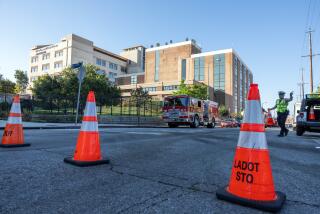V.A. Janitors Not Checked After Radioactive Spill
- Share via
The workers most likely to have been inadvertently contaminated by a radioactive spill at a San Diego hospital have not been checked for radiation exposure, authorities acknowledged Monday.
The workers are Veterans Administration Medical Center janitors responsible for vacuuming carpets in five elevators where a radioactive substance, probably phosphorus-32, was found.
The spill was discovered Friday morning but it has not been determined when it occurred. Since no one is sure when the phosphorus was tracked into the elevators, it is uncertain if the overnight maintenance workers were exposed only on Thursday night or on multiple nights, said Thomas Trujillo, hospital administrator.
“There’s a cleanup crew in there every night,” Trujillo said of the contaminated elevators. “I would hope that, through the investigation, we would be able to clear it up.”
However, until questioned by a reporter late Monday, neither Trujillo nor Nuclear Regulatory Commission investigators had considered the possibility that the maintenance workers might have been contaminated. Their previous assertion that there had been no potential danger to anyone as a result of the spill was made without considering the maintenance workers.
“I think you’ve got a possibility there,” said NRC spokesman Greg Cook, when asked about the janitors. “I’m going to take that question to our inspectors.”
Cook noted that a vacuum cleaner that was used to clean up a laboratory after the spill had radioactive material inside it.
“That was used to vacuum up wash water from the decontamination itself,” Cook said. “But that was not a general-use vacuum cleaner.”
Nightly vacuuming done in the elevators would have occurred before the spill was detected. If it were done with vacuum cleaners that had no special filters to prevent them from spewing small dust particles into the air, Cook said, then the maintenance workers might have been exposed to radioactive dust that they could have inhaled.
But Cook said he was somewhat reassured by the radioactivity pattern inspectors found in the elevator.
“The way the contamination was found, in spots, does not support the idea that a vacuum cleaner was blowing stuff around,” he said.
Ingestion or inhalation are the exposure routes of most concern in a phosphorus-32 spill, since external contact results in minimal radiation exposure.
Internally, however, a radioactive substance can lodge in an organ--in this case, possibly a lung--and irradiate the tissue until the body expels it or the radioactivity decays to negligible levels. Phosphorus-32 takes 14.3 days to decay to half of its previous level; the radioactivity from it would be considered negligible in 10 half-lives, or 143 days.
After the spill was discovered in a sixth-floor lab at the La Jolla Village Drive facility Friday morning, hospital officials began checking for contamination elsewhere and detected radioactivity in five elevators.
A cleanup began, and when NRC investigators arrived at midnight Friday they found that contamination remained in only one elevator.
Radioactive contamination also was found in the hematology-oncology lab under the supervision of Dr. William Waxman, from where the material apparently was tracked into a hallway and the elevators.
Officials monitored clothing of lab workers and found contamination on the shoes of two of them.
Investigators know that the type of radioactivity detected in the spill matches that of phosphorus-32, which is used in the lab where the spill originated. However, not until special tests are done will the radioactive substance’s identity be confirmed, Cook said.
More to Read
Sign up for Essential California
The most important California stories and recommendations in your inbox every morning.
You may occasionally receive promotional content from the Los Angeles Times.













